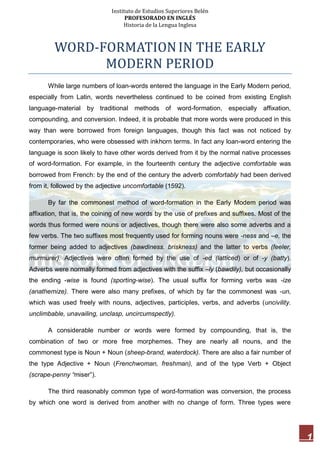Word formation in the Early Modern Period
•
0 likes•2,395 views
Report
Share
Report
Share
Download to read offline

Recommended
Recommended
More Related Content
What's hot
What's hot (20)
Morpheme, morphological analysis and morphemic analysis

Morpheme, morphological analysis and morphemic analysis
chapter 2. Words, Dictionaries and the mental lexicon (Morphology (Linguis...

chapter 2. Words, Dictionaries and the mental lexicon (Morphology (Linguis...
Similar to Word formation in the Early Modern Period
Similar to Word formation in the Early Modern Period (20)
More from Dante Rodolfo Acosta
More from Dante Rodolfo Acosta (20)
Recently uploaded
https://app.box.com/s/7hlvjxjalkrik7fb082xx3jk7xd7liz3TỔNG ÔN TẬP THI VÀO LỚP 10 MÔN TIẾNG ANH NĂM HỌC 2023 - 2024 CÓ ĐÁP ÁN (NGỮ Â...

TỔNG ÔN TẬP THI VÀO LỚP 10 MÔN TIẾNG ANH NĂM HỌC 2023 - 2024 CÓ ĐÁP ÁN (NGỮ Â...Nguyen Thanh Tu Collection
Mehran University Newsletter is a Quarterly Publication from Public Relations OfficeMehran University Newsletter Vol-X, Issue-I, 2024

Mehran University Newsletter Vol-X, Issue-I, 2024Mehran University of Engineering & Technology, Jamshoro
Recently uploaded (20)
Kodo Millet PPT made by Ghanshyam bairwa college of Agriculture kumher bhara...

Kodo Millet PPT made by Ghanshyam bairwa college of Agriculture kumher bhara...
Interdisciplinary_Insights_Data_Collection_Methods.pptx

Interdisciplinary_Insights_Data_Collection_Methods.pptx
NO1 Top Black Magic Specialist In Lahore Black magic In Pakistan Kala Ilam Ex...

NO1 Top Black Magic Specialist In Lahore Black magic In Pakistan Kala Ilam Ex...
Jual Obat Aborsi Hongkong ( Asli No.1 ) 085657271886 Obat Penggugur Kandungan...

Jual Obat Aborsi Hongkong ( Asli No.1 ) 085657271886 Obat Penggugur Kandungan...
TỔNG ÔN TẬP THI VÀO LỚP 10 MÔN TIẾNG ANH NĂM HỌC 2023 - 2024 CÓ ĐÁP ÁN (NGỮ Â...

TỔNG ÔN TẬP THI VÀO LỚP 10 MÔN TIẾNG ANH NĂM HỌC 2023 - 2024 CÓ ĐÁP ÁN (NGỮ Â...
Basic Civil Engineering first year Notes- Chapter 4 Building.pptx

Basic Civil Engineering first year Notes- Chapter 4 Building.pptx
Food safety_Challenges food safety laboratories_.pdf

Food safety_Challenges food safety laboratories_.pdf
Unit 3 Emotional Intelligence and Spiritual Intelligence.pdf

Unit 3 Emotional Intelligence and Spiritual Intelligence.pdf
HMCS Max Bernays Pre-Deployment Brief (May 2024).pptx

HMCS Max Bernays Pre-Deployment Brief (May 2024).pptx
Word formation in the Early Modern Period
- 1. Instituto de Estudios Superiores Belén PROFESORADO EN INGLÉS Historia de la Lengua Inglesa 1 WORD-FORMATIONIN THE EARLY MODERN PERIOD While large numbers of loan-words entered the language in the Early Modern period, especially from Latin, words nevertheless continued to be coined from existing English language-material by traditional methods of word-formation, especially affixation, compounding, and conversion. Indeed, it is probable that more words were produced in this way than were borrowed from foreign languages, though this fact was not noticed by contemporaries, who were obsessed with inkhorn terms. In fact any loan-word entering the language is soon likely to have other words derived from it by the normal native processes of word-formation. For example, in the fourteenth century the adjective comfortable was borrowed from French: by the end of the century the adverb comfortably had been derived from it, followed by the adjective uncomfortable (1592). By far the commonest method of word-formation in the Early Modem period was affixation, that is, the coining of new words by the use of prefixes and suffixes. Most of the words thus formed were nouns or adjectives, though there were also some adverbs and a few verbs. The two suffixes most frequently used for forming nouns were -ness and –e, the former being added to adjectives (bawdiness. briskness) and the latter to verbs (feeler, murmurer). Adjectives were often formed by the use of -ed (latticed) or of -y (batty). Adverbs were normally formed from adjectives with the suffix –ly (bawdily), but occasionally the ending -wise is found (sporting-wise). The usual suffix for forming verbs was -ize (anathemize). There were also many prefixes, of which by far the commonest was -un, which was used freely with nouns, adjectives, participles, verbs, and adverbs (uncivility. unclimbable, unavailing, unclasp, uncircumspectly). A considerable number or words were formed by compounding, that is, the combination of two or more free morphemes. They are nearly all nouns, and the commonest type is Noun + Noun (sheep-brand, waterdock). There are also a fair number of the type Adjective + Noun (Frenchwoman, freshman), and of the type Verb + Object (scrape-penny “miser”). The third reasonably common type of word-formation was conversion, the process by which one word is derived from another with no change of form. Three types were
- 2. Instituto de Estudios Superiores Belén PROFESORADO EN INGLÉS Historia de la Lengua Inglesa 2 especially common: the formation of verbs front nouns (to bayonet, to gossip, to invoice) the formation of nouns from adjectives (an ancient 'an old man', a brisk 'a fop'), and the formation of nouns from verbs (an invite, a laugh). The words formed by affixation, compounding, and conversion are often ordinary everyday words, or words to do with practical affairs like farming, fishing, and handicrafts. By contrast, as we have seen, Latin loan-words tend to be more formal and literary, and often concern specialized fields of discourse like science, medicine, religion, classical culture, and the liberal arts.
